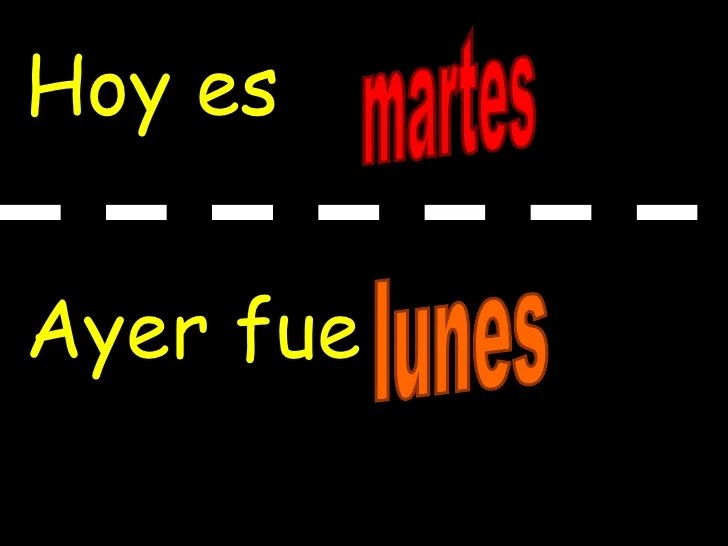Hoy es martes manana es – Hoy es martes, mañana es… ¿qué? Esta frase tan común en español esconde un significado más profundo de lo que parece. Acompáñanos en un viaje lingüístico y cultural para desentrañar los secretos de “hoy es martes, mañana es”.
Empezaremos por analizar la frase desde un punto de vista lingüístico, identificando sus partes y su estructura gramatical. Luego, exploraremos su uso en la vida cotidiana, con ejemplos y anécdotas que ilustran su significado en diferentes contextos.
Overview

The phrase “hoy es martes mañana es” in Spanish translates literally to “today is Tuesday tomorrow is” in English. This phrase is often used in Spanish-speaking countries to refer to the day after tomorrow. For example, if today is Tuesday, then “hoy es martes mañana es” refers to Wednesday.
The phrase does not have any particular cultural significance in Spanish-speaking countries. It is simply a way of referring to the day after tomorrow.
Linguistic Analysis: Hoy Es Martes Manana Es

The phrase “hoy es martes mañana es” is a Spanish phrase that means “today is Tuesday, tomorrow is.” Let’s analyze the parts of speech and grammatical structure of this phrase:
Parts of Speech
- hoy (adverb): today
- es (verb): is
- martes (noun): Tuesday
- mañana (noun): tomorrow
- es (verb): is
Grammatical Structure
The phrase follows a simple subject-verb-object structure. The subject is “hoy” (today), the verb is “es” (is), and the object is “martes” (Tuesday). The phrase “mañana es” (tomorrow is) follows the same structure, with “mañana” (tomorrow) as the subject and “es” (is) as the verb.
Unique Linguistic Features
One unique feature of this phrase is the use of the present tense to express future events. In English, we would typically use the future tense to say “tomorrow is Tuesday,” but in Spanish, the present tense is used to indicate that the event is certain and will happen in the near future.
Usage and Examples

The phrase “hoy es martes mañana es” is commonly used in everyday Spanish conversation to refer to the upcoming day, Wednesday. It is typically used in informal settings and among friends or family members.
For example, if someone is making plans for Wednesday, they might say “hoy es martes mañana es miércoles” to indicate that they are referring to the following day.
Regional Variations
The phrase “hoy es martes mañana es” is used throughout the Spanish-speaking world, but there may be some regional variations in its usage.
For example, in some regions of Spain, people might say “hoy es martes, mañana miércoles” instead of “hoy es martes mañana es miércoles.”
Comparison to Similar Phrases

The phrase “hoy es martes mañana es” is unique in its concise and straightforward way of expressing the idea of a task being postponed to the following day. However, there are other Spanish phrases that convey a similar meaning, each with its own nuances and implications.
Similar Phrases, Hoy es martes manana es
One common alternative is “mañana lo hago,” which translates directly to “I’ll do it tomorrow.” This phrase is often used in a more casual setting and implies a less urgent or pressing task. It suggests that the speaker intends to complete the task the following day, but without a strong sense of urgency.
Another similar phrase is “lo dejo para mañana,” which means “I’ll leave it for tomorrow.” This phrase conveys a stronger sense of procrastination or avoidance. It implies that the speaker has decided to postpone the task until the next day, often due to a lack of motivation or desire to complete it.
Hoy es martes por la mañana y es un día perfecto para repasar la historia de Estados Unidos. Si estás estudiando para la unidad 4, no olvides consultar esta prueba de práctica para ponerte a prueba. Volviendo a hoy, martes por la mañana, ¡disfruta de un café y prepárate para un día productivo!
Finally, the phrase “ya lo haré” translates to “I’ll do it eventually.” This phrase is often used to express a lack of commitment or a dismissive attitude towards the task. It suggests that the speaker does not intend to complete the task promptly and may even be considering not doing it at all.
Cultural Implications

The phrase “hoy es martes mañana es” is deeply rooted in Spanish-speaking culture, reflecting the importance of family, community, and tradition.
In many Spanish-speaking cultures, Tuesday is considered a day of family and community gatherings. Families often gather for meals, share stories, and enjoy each other’s company. The phrase “hoy es martes mañana es” serves as a reminder of these cherished traditions, emphasizing the value of spending quality time with loved ones.
Historical and Literary References
The phrase “hoy es martes mañana es” has been used in Spanish literature and folklore for centuries. In the 16th-century novel “Don Quixote,” the protagonist, Don Quixote, often uses the phrase to remind himself of the importance of living in the present moment and cherishing the time he has with his companions.
The phrase has also been referenced in popular songs and poems, further solidifying its place in Spanish-speaking culture. For example, the Mexican folk song “Cielito Lindo” includes the line “hoy es martes mañana es,” underscoring the enduring popularity of the phrase.
FAQ Corner
¿Qué significa literalmente “hoy es martes, mañana es”?
Hoy es martes y mañana será miércoles.
¿Cuál es el significado cultural de esta frase?
Representa la idea de que el tiempo avanza inexorablemente y que debemos aprovechar el presente.
¿Cómo se usa esta frase en la conversación diaria?
Se utiliza para recordar que el tiempo pasa rápido y que debemos hacer las cosas que queremos hacer hoy, no mañana.